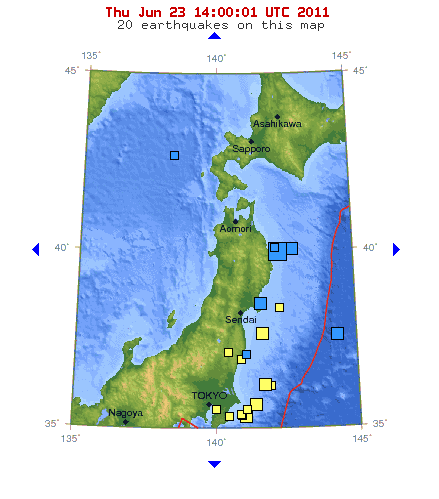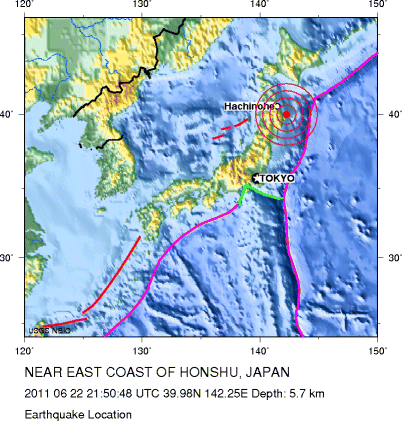6.7 earthquake rumbles along northeast coast of Japan

A 6.7-magnitude earthquake rumbled off the northeastern coast of Honshu, Japan early Thursday morning, local time.
The epicenter of the quake was close to where the devastating 9.0-magnitude earthquake struck on March 11, 2011. The center of the magnitude 6.7 earthquake was 54 miles southeast of Hachinohe, Japan and 325 miles north-northeast of Tokyo. The depth of the quake was approximately 20 miles below the ocean floor.
The USGS reports that light to moderate shaking was felt in northeastern Japan early Thursday morning, in the same areas that were impacted by the March earthquake and resulting tsunami.
A tsunami warning was initially issued, but was canceled an hour later.
Fortunately, it does not appear as if there were widespread damage reports resulting from the Thursday morning temblor.
Several aftershocks occurred well after the 6.7-magnitude earthquake Thursday morning, including a 5.3-magnitude earthquake at 7:35 p.m. Thursday, local time. (…)
A magnitude 6.7 earthquake rocked Japan June 22nd, the 75th aftershock of at least magnitude 6.0 from the devastating magnitude 9.0 quake on March 11, according to the U.S. Geological Survey (USGS). The earthquake data is preliminary and subject to revision.
Japan has been rocked by hundreds of aftershocks since the deadly Tohoku earthquake, the biggest in Japan’s recorded history. The aftershocks have been so plentiful that the world’s premier earthquake-measurement service has since modified its alert system to filter out the smaller aftershocks. The largest aftershock was a magnitude 7.9 quake that struck less than an hour after the main shock. A magnitude 7.7 also struck that day. A magnitude 7.1 aftershock struck on April 7.
The number of aftershocks seems staggering, but geologists are not surprised, especially for such large mainshock. The rule of thumb for aftershock strength is that the biggest aftershock will be about one magnitude smaller than the mainshock. The latest aftershock struck about 54 miles (88 kilometers) east of Honshu. The quake ruptured 20 miles (32 km) below the Earth’s surface.
Since the main quake off Japan’s northeastern coast, hundreds aftershocks have shaken the island of Honshu, Japan’s largest and home to 100 million people. Today’s aftershock was caused by thrust faulting near the Japan Trench, the boundary between the Pacific and North America tectonic plates (the huge, moving slabs of the Earth’s crust). Thrust faulting happens when one tectonic plate dives under another. In this case, the Pacific plate is diving under the North America plate.
Before the magnitude 9.0 earthquake, only nine magnitude 7.0 or greater earthquakes had ruptured in this subduction zone since 1973.


Commenting rules and guidelines
We value the thoughts and opinions of our readers and welcome healthy discussions on our website. In order to maintain a respectful and positive community, we ask that all commenters follow these rules.